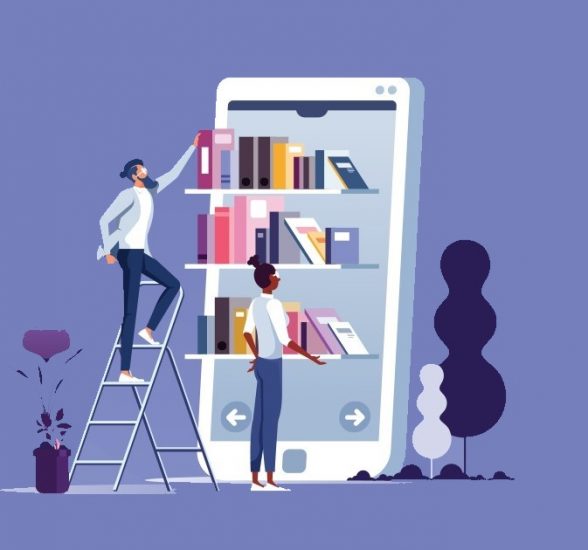By Daniel Davis
Edited by Max Gonzalez Burdick, Sarah Walters, Sereen Suleiman

Source: https://resources.overdrive.com/library/marketing-outreach-social/
Marketing and libraries are two things that many, perhaps most, people would not normally associate with each other. Some may consider marketing a corporate function. They might not consider marketing to be a skill librarians possess, nor one that is necessary in particular in special libraries, with their captive audiences. Both of these are misconceptions. Buehler (2020) wrote that special libraries “cannot afford to sit on their hands and wait for patrons to discover the benefits of utilizing a special library” (p. 59).
Why should special librarians be concerned with marketing their programs and services? Well, in a study of 33 academic and special libraries in Finland, Singh (2009) found that “a greater degree of market orientation corresponds to a greater level of achievement in the service effectiveness of the library services, the ultimate result being higher customer satisfaction” (p. 127).
Marketing also allows special librarians to communicate what they add to their organization. Affelt (2011) wrote, “Information professionals need to be proactive in touting the value of what they bring to information, rather than waiting to react if the value is questioned” (p. 159).
Strife (1995), meanwhile, argued that “all librarians need to be concerned about the image of the library in their organizations. This concern is more urgent in specialized, for-profit libraries because an information center lives and dies by monetary support or lack thereof” (p. 418).
Strife’s point highlights one of the aspects that differentiates marketing in a special library from a public library setting: the need to market internally. Some of the practices will be the same, as many special library patrons are internal employees, so there is considerable overlap in marketing to them and marketing externally to public library patrons.
Audience
Information professionals in special libraries must also work on “gaining the ear of top management, as well as researchers and other personnel who make more direct use of library services” (Leerburger, 1982, p. 92). In other words, special librarians should direct internal marketing efforts both at employees who actually use library resources and at stakeholders, such as executives who may not use the library but have the power to make decisions that impact the library and its operations.

Source: https://leverageedu.com/blog/marketing-management/
Spreading the Word
Marketing is chiefly about communication. The special librarian must communicate in order to raise awareness of their services and resources. Demonstrating contributions and values added to executives and upper management is essential to how the special library serves the mission of the institution. Rogers and Densch (2017), in describing how their organization’s corporate information center went “from ‘the best kept secret in the company’ to a well-known and valued asset” (p. 455), conducted a scenario-building session for the center and “found a common thread in all the scenarios—the critical importance of systematic outreach and education” (p. 456).
The internet provides powerful platforms for special librarians to perform these functions. Rogers and Densch (2017) claimed, “Marketing your expertise through a virtual presence requires a thoughtful approach, some new skills, and a bit of trial and error, but it is one of the most important marketing channels you will use” (p. 472). These online channels include a library-specific website and social platforms such as Twitter and Instagram. Rogers and Densch (2017) also recommended that information professionals “leverage internal social networking to make yourself more visible and provide a channel for employees to use your resources” (p. 470).
Evaluation
How does a special librarian know if all their internal marketing efforts are working? Lawton (2016) advised, “A good place to start for all librarians thinking about impact is with the reader or user” (p. 182). Strife (1992) placed a tremendous amount of faith in user satisfaction, saying the measurement “is a key to evaluating library services. Unsatisfied users can be a reason to cut the technical information budget or eliminate it entirely” (p. 55). This should thus be a crucial metric for special librarians to track.
Perhaps the best and easiest way to measure user satisfaction is through surveys. Powers (1995) observed that because “special libraries often provide very specific individualized client services . . . Offering each client the opportunity to comment before, during, and after the service is performed may be an excellent way to provide evaluative services.” Beyond tracking user satisfaction, though, Plosker (2017) also noted that “surveys often have many benefits including an implicit messaging and outreach impact that goes beyond just obtaining comments and feedback about the event.” In other words, the surveys not only uncover how users feel about the special librarian’s services and special library’s resources, they also offer guidance for how to communicate to patrons.
Conclusion
Effectively marketing to internal audiences to achieve desired objectives requires work. Plosker (2017) wrote, “Ultimately, the objective of in-house marketing is to increase the visibility, awareness, and recognition of the library. Increasing user knowledge of the depth and range of library tools and services is part of this too.”
Special librarians have the motivation and the means to do this. The means include identifying and understanding the internal users and stakeholders, reaching out to these audiences about the services and resources the special librarian provides, and educating the audiences about the contributions and value the library and librarian add to the organization. The motivation is to ensure the very health and sustainability of the special library itself. The stakes are high, but with thoughtful planning and strong execution, the internal marketing program will pay dividends for the special library and the special librarian.
References
Affelt, A. (2011). Best practices for aligning the mission and marketing the services of the corporate library. In S. E. Kelsey & M. J. Porter (Eds.), Best practices for corporate libraries (pp. 153–166). ABC-CLIO. https://publisher-abc-clio-com.libaccess.sjlibrary.org/9781598847383/168
Buehler, N. R. (2020). Outreach in public, special, and academic libraries. The Serials Librarian, 79(1/2), 57–61. https://doi-org.libaccess.sjlibrary.org/10.1080/0361526X.2020.1772174 (SJSU Access)
Lawton, A. (2016). The invisible librarian. Elsevier Science & Technology. https://doi.org/10.1016/B978-0-08-100171-4.12001-4
Leerburger, B. A. (1982). Marketing the library. Knowledge Industry Publications.
Plosker, G. (2017). Marketing of library services – partnerships, programs, and relationships. Special Libraries Association. https://www.sla.org/wp-content/uploads/2017/07/Plosker_Final-SLA_2017_Paper_v2.pdf
Powers, J. E. (1995). Marketing in the special library environment. Library Trends, 43(3), 478+. https://link.gale.com/apps/doc/A16709322/GPS?u=csusj&sid=primo&xid=4312de38
Rogers, A. E., & Densch, K. L. (2017). Marketing your expertise. In J. M. Matarazzo & T. Pearlstein (Eds.), The Emerald Handbook of modern information management (pp. 455–474). Emerald Publishing Limited. https://ebookcentral-proquest-com.libaccess.sjlibrary.org/lib/sjsu/detail.action?docID=4981621
Singh, R. (2009). Does your library have a marketing culture? Implications for service providers. Library Management, 30(3), 117–137. https://doi.org/10.1108/01435120910937302
Strife, M. L. (1992). Special libraries assessment or marketing the special library. The Reference Librarian, 17(38), 53–56. https://doi-org.libaccess.sjlibrary.org/10.1300/J120v17n38_07 (SJSU Access)
Strife, M. L. (1995). Special libraries and instruction. The Reference Librarian, 24(51–52), 415–419. https://doi-org.libaccess.sjlibrary.org/10.1300/J120v24n51_35 (SJSU Access)
Wakeham, M. (2004). Marketing and health libraries. Health Information and Libraries Journal, 21(4), 237–244. https://doi.org/10.1111/j.1471-1842.2004.00540.x



0 Comments